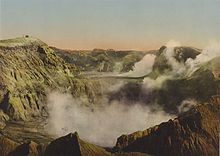Waimangu Geyser
The Waimangu Geyser was a geyser in the Waimangu Valley near Rotorua on the North Island of New Zealand . It was the largest geyser in the world.
The geological conditions for a geyser were probably created by the eruption of Mount Tarawera in 1886, which opened a 14 km long trench down the mountain and through Lake Rotomahana .
The first outbreak was observed in 1900. In individual eruptions it reached a maximum of 400 to 460 m, usually around 100 to 150 m in height. This made it the highest geyser in the world. The highest geyser in the world that is active today, the Steamboat Geyser in the USA, reaches a height of around 100 m. The largest geyser in New Zealand is now the Pohuto in Whakarewarewa with a maximum height of 30 m.
The water of the geyser was black because of the stones and mud it carried away, so that the Māori called the geyser “Waimangu” (“black water”). The geyser gave the valley and the entire thermal area, the Waimangu Volcanic Rift Valley , its name.
After the eruption of the Tarawera in 1886 destroyed New Zealand's most important tourist attraction, the Pink and White Terraces , tourism began to develop again around the geyser. 1902–1903 a larger tourist accommodation was built at the entrance to the valley and shelters with a view of the geyser. The refuge to the south was later removed because it was in the throwing area of the ejected stones. In 1903 more and more visitors came.
On August 10, 1903, the tourist guide Alfred Warbrick and a Mr. Buckridge, mate on the yacht Tilikum, rode the geyser lake for twelve minutes in a rowboat on the basis of a bet. They took measurements and found the lake 14.6 m deep and 130 × 80 m in size. The unexpectedly shallow depth was attributed to the fact that the stones thrown up fell back into the chimney after the eruption.
On August 31, 1903, four tourists, including national rugby player Joseph Warbrick , were killed after ignoring repeated instructions from their guide, Alfred Warbrick, Joseph's brother, to return to a safe distance. They were close to the edge of the geyser when it suddenly erupted. The four tourists were washed down the geyser drain by hot water and mud and perished.
As a result of a landslide that changed the water table, activity suddenly stopped on November 1, 1904, after having already decreased during the year.
The vent, a basin surrounded on three sides by hills, is located in the Waimangu Valley in the northeast of the Echo Crater with the "Frying pan lake" and can be visited.
Individual evidence
- ^ ES Moore: The Active Volcanoes of New Zealand. In: The Journal of Geology. 25 (8) (November-December 1917), University of Chicago Press, p. 708.
- ↑ a b c Te ara. In: The Encyclopedia of New Zealand. Retrieved December 29, 2011.
- ↑ a b c d R. F. Keam: Eruption Chronicle 3 Waimangu Geyser. Waimango Volcanic Valley information sheet. (PDF file; 368 kB).
- ↑ The outbreak of Waimango Recalled. In: Feilding Star. Vol. XIII, Issue 3209, April 5, 1917, p. 1 (digitized version)
- ^ United Press Association: Waimangu Geyser - 1903. In: New Zealand Disasters and Tragedies. August 31, 1903, accessed January 21, 2007 .
- ^ J. Malcolm MacLaren: The Source of the Waters of Geysers' . In: The Geological Magazine . tape 3 , no. 11 . Cambridge University Press, Nov. 1906, pp. 512 .
Web links
- Images of the Waimangu Geyser in the collections of the Alexander Turnbull Library
Coordinates: 38 ° 17 ′ 0 ″ S , 176 ° 24 ′ 0 ″ E


